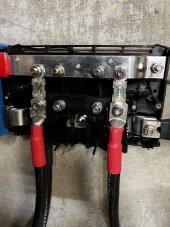byteharmony
Sunny side up please.
I'm going to push 275 AMPS at 48v from my batteries.
To do that I'll start with 3 trophy 100 AH batteries.
if it was just 2 I could wire each battery right to the sol ark 15k, but there's 3. Sooo a bus bar.
This video inspired me to post this question:
To do that I'll start with 3 trophy 100 AH batteries.
if it was just 2 I could wire each battery right to the sol ark 15k, but there's 3. Sooo a bus bar.
This video inspired me to post this question:




